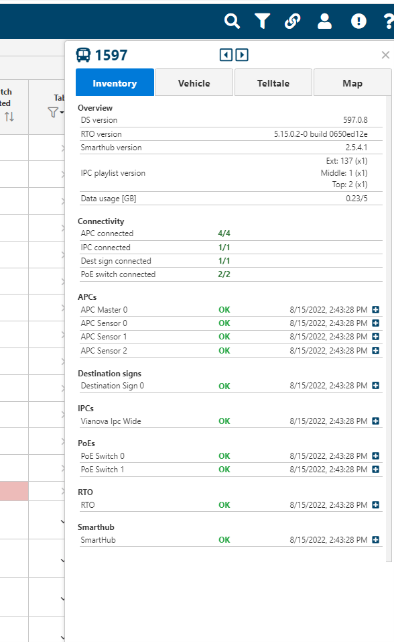 Public Transport Operators (PTOs) work hard to ensure their buses are ready for operation. Having confidence that all the on-board equipment such as validators, Passenger Counting sensors and screens are all working as needed, is a key part of their commitment to ensure a safe and comfortable journey for passengers.
Public Transport Operators (PTOs) work hard to ensure their buses are ready for operation. Having confidence that all the on-board equipment such as validators, Passenger Counting sensors and screens are all working as needed, is a key part of their commitment to ensure a safe and comfortable journey for passengers.
The challenge the market now faces, is that with so many vendors supplying on-board kit, multiple systems are needed to monitor everything. This means that ongoing monitoring and fleet management is distributed between PTAs, PTOs, vehicle manufacturers and traffic controllers. It is therefore impossible to get a comprehensive overview in one place, and no unified way of obtaining that information.
With the responsibility sitting with PTAs to ensure that travellers experience the best possible service, knowing how each bus is performing is essential.
But why is this so important for PTAs?
Firstly, to meet passenger expectations:
- Is the PTO providing a trustworthy service to passengers?
- Are the On-Time, Ticketing and Passenger Information systems working?
Secondly, to ensure safety and bus readiness:
- Is the vehicle operational, charged and ready to drive?
- Is the on-board equipment such as screens and validators working correctly?
- Is the bus operating according to agreed standards?
So, how can FARA help?
By providing a set of tools to provide RTI for asset management and web-based monitoring.
The ITxPT certified FARA Vehicle Communications Gateway (SmartHUB) can help provide the data required, as well as a centralised vehicle asset management and inventory status.
We have a number of key data points that feed into our web-based monitoring that provide important insight required to measure bus performance:
- Device Health Alarms
- Vehicle Alarms
- Battery Monitoring
- Electrical Charging
- Climate Control
Using the Vehicle Communications Gateway and data points to run efficient operations
There are 4 areas we focus on to enable PTAs and PTOs to closely monitor and easily manage their operations.
1. Device Status Check
This solution monitors the state and health of the devices in the vehicle, including network ping status and ITxPT Vehicle inventory status.
ITxPT connected equipment are verified using the ITxPT S02 Module inventory functionality, checking SW/HW Versions, Failures OK/Warning and Modules.
Examples of equipment that can be monitored include Vehicle Communications Gateway (VCG), Multi Application Driver Tablet (MADT), Dynamic Passenger Information (DPI) screens, Automatic Passenger Counting (APC) sensors and Ethernet switches, as shown below.

Application specific checks can also be performed, such as printer status, infotainment playlist, configuration files etc.
The good news is that AFC and/or RTI equipment not currently delivered by FARA can also be monitored with this solution.
The vehicle and fleet monitoring can be shared between the PTA and PTO. The PTA may want to know current status, but not necessary fix any problems, and the PTO may have a contractual agreement to do just that. The PTO will also have more vehicle details available in their Portal view, to be able to make the necessary adjustments.
2. Vehicle Error Reporting
The traditional way of reporting vehicle errors is walking around with a clipboard and completing a paper checklist, which again must be further processed.
FARA has fully automated this reporting process, and vehicle errors are detected and reported. This can happen two ways:
- Automatically – the Vehicle Communication Gateway monitors the CAN-FMS data to detect and report indications that the vehicle is not ready or safe for operation, such as a warning light in the dashboard.
- Manually – via the Driver Interface, the driver can manually report errors like missing fire extinguishers or broken windshields.

The status of errors in the vehicle are available for the driver, and each error type can be toggled on/off, and additional information can be provided by the driver if needed.
Traffic Controllers monitor and get alerts of vehicle errors reported. All vehicle error history is available, and manual errors can be cleared or marked as handled. Uptime reports for the equipment are also available and the error types and their attributes (like importance) are fully configurable.
3. Vehicle Asset Management
 In addition to an overview of basic vehicle information like vehicle type, doors, engine seats etc., the Vehicle Asset Management tool also gives an overview of all equipment installed in the vehicle such as validators, screens, Automatic Passenger Counting (APC) sensors, destination signs and comms.
In addition to an overview of basic vehicle information like vehicle type, doors, engine seats etc., the Vehicle Asset Management tool also gives an overview of all equipment installed in the vehicle such as validators, screens, Automatic Passenger Counting (APC) sensors, destination signs and comms.
4. Active Traffic Control
Active Traffic Control (ATC) is the FARA solution for Fleet and Traffic Management live monitoring, dispatching and driver/vehicle control, as well as providing statistics and reports.
The ATC combines the inventory and status in easily accessible views, giving the operator full overview of the status of the operation:


In summary…
The teams at FARA are here to make travel easy, and to provide PTAs and PTOs with access to the latest technology to help them run their services as effectively as possible.
This summary from our recent webinar is just a snapshot of what our full RTI solution consists of but form the essential toolkit available to help provide a holistic overview of bus performance.
For more information on the above, or if you would like to discuss this further, then please get in touch with us here.
